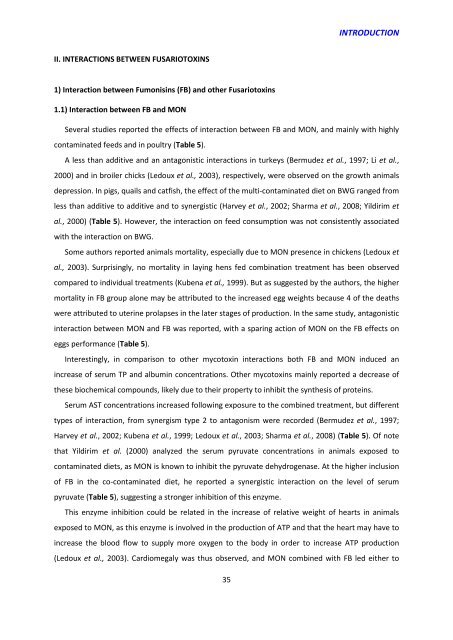Effet chez le porcelet d'une exposition à un régime co-contaminé en ...
Effet chez le porcelet d'une exposition à un régime co-contaminé en ...
Effet chez le porcelet d'une exposition à un régime co-contaminé en ...
Create successful ePaper yourself
Turn your PDF publications into a flip-book with our unique Google optimized e-Paper software.
INTRODUCTIONII. INTERACTIONS BETWEEN FUSARIOTOXINS1) Interaction betwe<strong>en</strong> Fumonisins (FB) and other Fusariotoxins1.1) Interaction betwe<strong>en</strong> FB and MONSeveral studies reported the effects of interaction betwe<strong>en</strong> FB and MON, and mainly with highly<strong>co</strong>ntaminated feeds and in poultry (Tab<strong>le</strong> 5).A <strong>le</strong>ss than additive and an antagonistic interactions in turkeys (Bermudez et al., 1997; Li et al.,2000) and in broi<strong>le</strong>r chicks (Ledoux et al., 2003), respectively, were observed on the growth animalsdepression. In pigs, quails and catfish, the effect of the multi-<strong>co</strong>ntaminated diet on BWG ranged from<strong>le</strong>ss than additive to additive and to synergistic (Harvey et al., 2002; Sharma et al., 2008; Yildirim etal., 2000) (Tab<strong>le</strong> 5). However, the interaction on feed <strong>co</strong>nsumption was not <strong>co</strong>nsist<strong>en</strong>tly associatedwith the interaction on BWG.Some authors reported animals mortality, especially due to MON pres<strong>en</strong>ce in chick<strong>en</strong>s (Ledoux etal., 2003). Surprisingly, no mortality in laying h<strong>en</strong>s fed <strong>co</strong>mbination treatm<strong>en</strong>t has be<strong>en</strong> observed<strong>co</strong>mpared to individual treatm<strong>en</strong>ts (Kub<strong>en</strong>a et al., 1999). But as suggested by the authors, the highermortality in FB group alone may be attributed to the increased egg weights because 4 of the deathswere attributed to uterine prolapses in the later stages of production. In the same study, antagonisticinteraction betwe<strong>en</strong> MON and FB was reported, with a sparing action of MON on the FB effects oneggs performance (Tab<strong>le</strong> 5).Interestingly, in <strong>co</strong>mparison to other my<strong>co</strong>toxin interactions both FB and MON induced anincrease of serum TP and albumin <strong>co</strong>nc<strong>en</strong>trations. Other my<strong>co</strong>toxins mainly reported a decrease ofthese biochemical <strong>co</strong>mpo<strong>un</strong>ds, likely due to their property to inhibit the synthesis of proteins.Serum AST <strong>co</strong>nc<strong>en</strong>trations increased following exposure to the <strong>co</strong>mbined treatm<strong>en</strong>t, but differ<strong>en</strong>ttypes of interaction, from synergism type 2 to antagonism were re<strong>co</strong>rded (Bermudez et al., 1997;Harvey et al., 2002; Kub<strong>en</strong>a et al., 1999; Ledoux et al., 2003; Sharma et al., 2008) (Tab<strong>le</strong> 5). Of notethat Yildirim et al. (2000) analyzed the serum pyruvate <strong>co</strong>nc<strong>en</strong>trations in animals exposed to<strong>co</strong>ntaminated diets, as MON is known to inhibit the pyruvate dehydrog<strong>en</strong>ase. At the higher inclusionof FB in the <strong>co</strong>-<strong>co</strong>ntaminated diet, he reported a synergistic interaction on the <strong>le</strong>vel of serumpyruvate (Tab<strong>le</strong> 5), suggesting a stronger inhibition of this <strong>en</strong>zyme.This <strong>en</strong>zyme inhibition <strong>co</strong>uld be related in the increase of relative weight of hearts in animalsexposed to MON, as this <strong>en</strong>zyme is involved in the production of ATP and that the heart may have toincrease the blood flow to supply more oxyg<strong>en</strong> to the body in order to increase ATP production(Ledoux et al., 2003). Cardiomegaly was thus observed, and MON <strong>co</strong>mbined with FB <strong>le</strong>d either to35

















